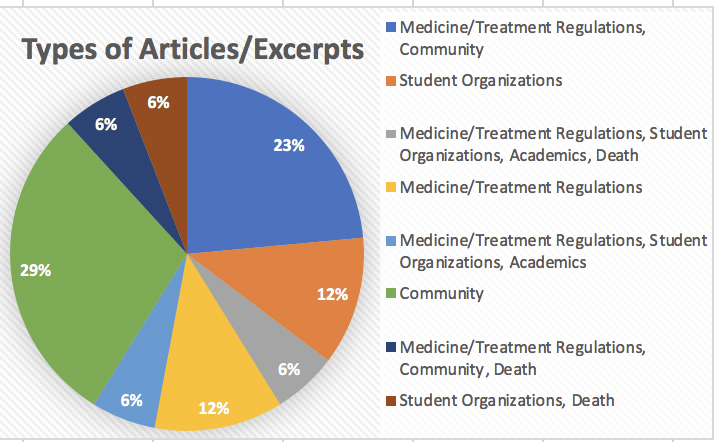Introduction
From the scarlet fever outbreak of 1907 to the COVID-19 epidemic today, health-related disasters have had a notable impact on the Amherst College community. Amidst the trials and tribulations of World War I in 1918, the Spanish influenza epidemic, or the “Spanish Flu,” stirred panic, precaution, and fear within the Amherst Community, leaving a great impact on students, faculty, and staff and being one of the most memorable natural and human-made disasters in Amherst’s history. Examining the words and language of eight different Amherst Student Newspaper issues is important to exploring this health crisis during the fall of 1918 and understanding the student and administrative responses to and perspectives of the crisis.
Methods
Exploring the Big Picture
Articles and excerpts on the epidemic from eight issues of the Amherst Student Newspaper from the Fall of 1918 were added to a text document used in the analysis of the crisis. Figure 1 shows the types of articles and excerpts within the document.

The first article found from that fall from September 1918 captured student fears towards the epidemic and discussed the College’s plans to continue monitoring the situation and conducting classes as usual. The last article from December 1918 talked about how Professor Robert Frost fared as he recovered from a bad case of influenza (“Briefs” 4). By looking at both of these articles and excerpts at very different periods of time, it is clear that the influenza crisis became more complex and devastating as the semester went on; during that fall, it went from being a minor crisis to one that affected the community on a larger scale.
Creating a Timeline
Timeline JS, a program that creates timelines, was used to organize the major timepoints in the crisis to create a timeline. The timeline is quite dynamic and complex and provides a concrete visual representation for the Spanish Flu during the fall of 1918. The first event in the timeline is the establishment of precautions to combat the spread; the last event describes the health status of two sick individuals and reiterates the impact of the epidemic over the course of the fall.

You must be logged in to post a comment.